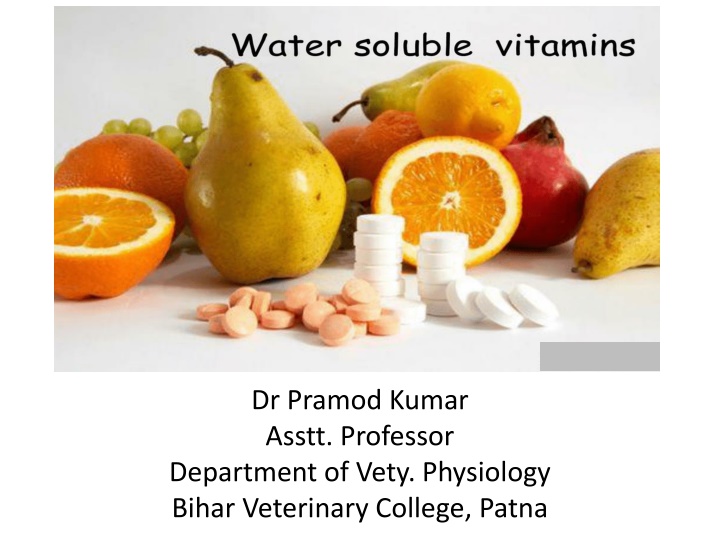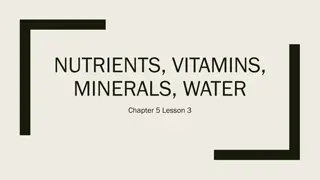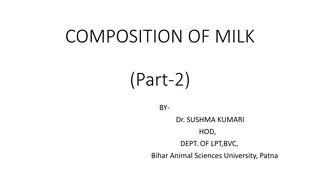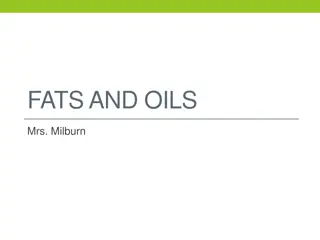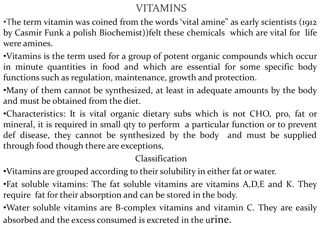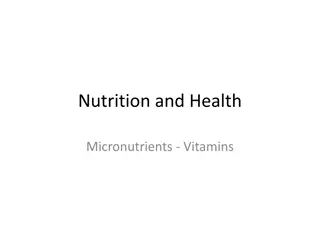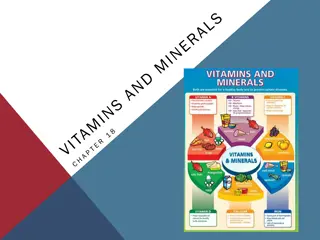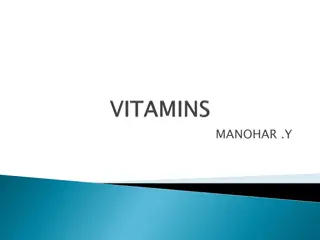Introduction to Vitamins and Their Importance in Health
Vitamins are essential organic compounds required in small amounts for optimal growth and health. Originating from the Greek word "VITAMINE," meaning vital for life, vitamins play crucial roles as coenzymes in various biochemical reactions. Water-soluble vitamins like Thiamine, Riboflavin, and Niacin have distinct structures and functions, affecting energy metabolism, redox reactions, and overall health. Deficiencies in these vitamins can lead to specific manifestations like Beri-beri for Thiamine and Pellagra for Niacin, emphasizing the importance of a balanced diet for overall well-being.
Download Presentation

Please find below an Image/Link to download the presentation.
The content on the website is provided AS IS for your information and personal use only. It may not be sold, licensed, or shared on other websites without obtaining consent from the author.If you encounter any issues during the download, it is possible that the publisher has removed the file from their server.
You are allowed to download the files provided on this website for personal or commercial use, subject to the condition that they are used lawfully. All files are the property of their respective owners.
The content on the website is provided AS IS for your information and personal use only. It may not be sold, licensed, or shared on other websites without obtaining consent from the author.
E N D
Presentation Transcript
Dr Pramod Kumar Asstt. Professor Department of Vety. Physiology Bihar Veterinary College, Patna
Introduction Vitamins required in the diet in small amounts to perform specific biologic functions for normal maintenance of optimum growth and health. are organic compounds The word Vitamin comes from the Greek word VITAMINE which means Vital for Life.
General Properties o Heterogeneous group of compounds and they differ chemically from each other. o soluble in water. o Excreted in the urine and are non-toxic to the body. o Not stored in large quantities (except B12) being continuously supplied in the diet. o These vitamins form coenzymes (active form of vitamin) that help to participate in a variety of biochemical reactions.
Thiamine (Vitamin B1) contains a pyrimidine and a thiazole ring. active form is the coenzyme Thiamine Pyrophosphate (TPP). activation occurs mainly in liver. TPP is involved with the energy releasing reactions of carbohydrate metabolism. Deficiency cause & Manifestations: Inadequate Diet, Pregnancy and lactation, Beri-beri I. Wet BB: Edema and weak heart muscles II. Dry BB: Degeneration of peripheral nerves and weak muscles. III. Infantile BB: Affects infants.
Riboflavin (Vitamin B2) Structure: Isoalloxazine ring attached to Ribitol. Stable to heat but (photosensitive). Active Coenzymes: Flavin adenine dinucleotide = Flavin mononucleotide + AMP forms in intestine and liver. Biochemical Functions: isoalloxazine ring serves as an acceptor of two hydrogen atoms. The coenzymes participate reduction reactions Transport Chain. Deficiency cause & Manifestation: Phototherapy, Pregnancy and Lactation Glossitis, Dermatitis & Cheilosis sensitive to light in many in oxidation Electron and the
Niacin (nicotinic acid/B3) Pyridine derivative - amide form is known as Niacinamide or Nicotinamide Structure - Synthesized Tryptophan Two active coenzymes: Formed in the Liver NAD+ and NADP+ Biochemical Functions - Coenzymes NAD+ (NADH) and NADP+ (NADPH) are involved in oxidation reduction reactions in carbohydrate, metabolisms. Deficiency causes & Manifestation: Inadequate Diet, Pregnancy and Lactation & Vitamin B6 deficiency: Pellagra is characterized 3 D s (Dermatitis, Diarrhea and Dementia) endogenously from lipid and protein
Pyridoxine (Vitamin B6) Vitamin B6 represent three compounds pyridoxine, pyridoxal and pyridoxamine. Structure - pyridine derivatives and active Coenzyme is Pyridoxal Phosphate (PLP), synthesized in the intestine from all the three forms. Biochemical Functions - These are closely associated with the metabolism of Amino acids. Deficiency cause Antituberculous drug, Oral Contraceptive Pills Neurological, Dermatological Hematological manifestations. & Manifestation: and
Vitamin C (Ascorbic Acid) Structure - resembles a carbohydrate (hexose). Heat sensitive and destroyed by cooking. Does not have any active coenzyme form but acts as a strong reducing agent. Biochemical hydroxylation of proline and lysine. These are essential for the collagen cross-linking and the strength of the fibre. Functions: required for Antioxidant Role: acts as an antioxidant preventing tissue injury due to oxidative damage by free radicals: Fights infection, Reduces risk of cancer and coronary artery disease.
Immunological synthesis of Immunoglobulins and increases the phagocytic functions of leukocytes. Function: enhances the Deficiency under the skin, bone fragility, joint pain, Poor wound healing, frequent infections, Spongy and bleeding gums, loosened teeth. Deficiency is manifested as Scurvy Manifestations: Hemorrhages
Cobalamin (Vitamin B12) Structure - Cobalamin contains a corrin ring with four pyrolle rings and COBALT at the centre. Two active coenzyme: Deoxadenosyl & Methylcobalamin Absorption and Storage: Absorption requires a glycoprotein known as intrinsic factor produced in the stomach in presence of HCL and stored in the liver in the form of Deoxyadenosyl Cobalamin. Biochemical Homocysteine Thus B12 deficiency results in decreased THF that leads to reduced nucleotide and DNA synthesis. Vitamin B12 is deficient abnormal fatty acids incorporated into cell membrane Deficiency cause & Manifestations: Vitamin B12 is mainly present in animal diet, Decreased absorption due to Gastrectomy and malabsorption diseases, Pernicious Anemia, Pregnancy and lactation Megaloblastic Anemia and Nervous Manifestation Functions: Synthesis of Methionine from
